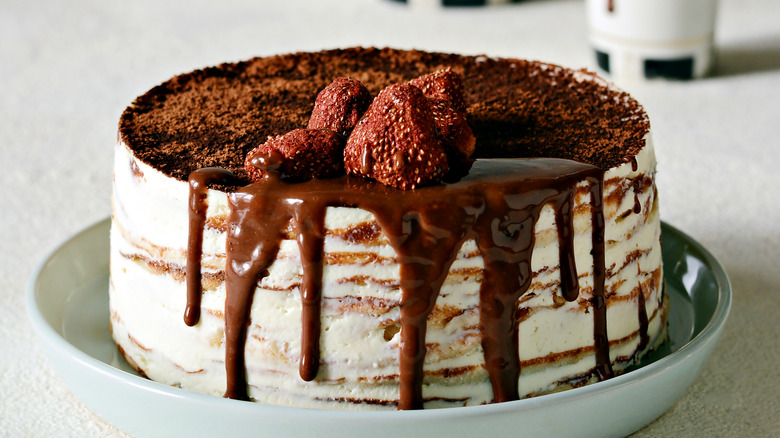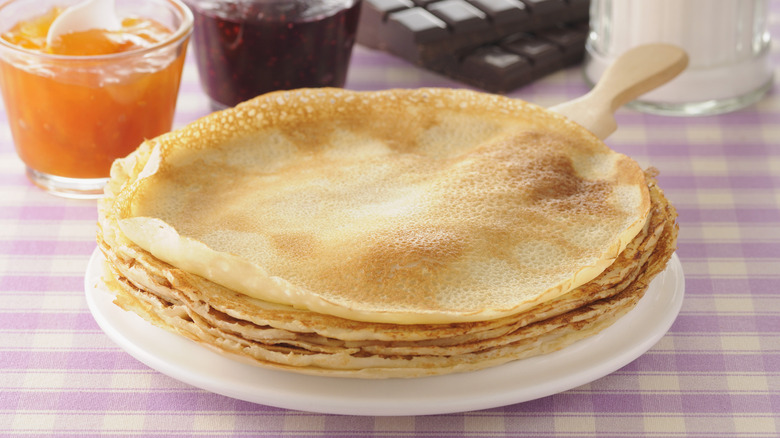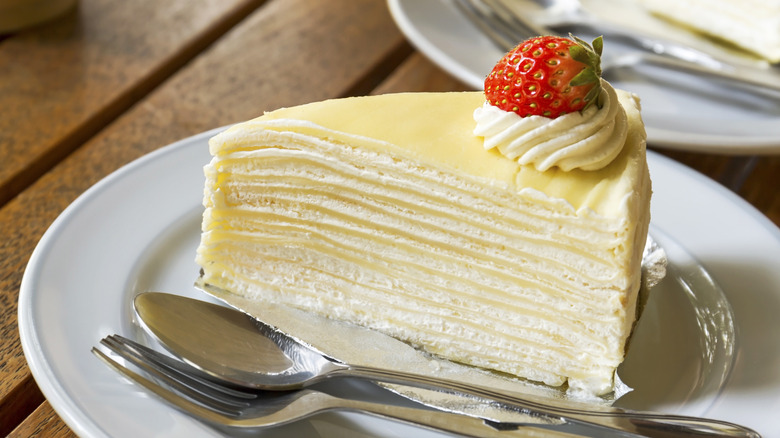For The Ultimate Crepe Cake, Watch How Much Butter You Use
Although crepes are often enjoyed as a dessert on their own (especially if they contain a super sweet filling, like fresh fruit or some Nutella), making a crepe cake can be a fun and creative way to put a spin on the treat.
When cooking up your crepes, however, you'll need to pay close attention to how much butter is being used. The ultra-thin food will need a little bit in the pan to prevent it from sticking, and to make flipping each crepe easier. However, too much butter in the pan could lead to overcooked crepes, making for an inconsistent color on each one. Too much butter could also leave each crepe with a slightly greasy texture, making it difficult to build the cake properly.
To avoid over-buttering your pan, don't simply scrape a pat of butter in and let it melt. Instead, melt your butter in a separate bowl, and keep a pastry brush nearby. The best pastry brushes are made of natural or silicone bristles. You can use the brush to add a small amount of butter to the pan in between crepes. The brush will keep things light, eliminating the risk of using too much butter.
Too much butter could cause problems
When they're made properly, perfectly cooked crepes are supposed to be fairly limp, making them easy to work with. When they're enjoyed on their own, they can be rolled or folded with fillings inside. But when making a crepe cake, that consistency is especially important for allowing all of the layers to stack together well.
Adding too much butter into the pan when cooking crepes could make the food cook too quickly. The fat in the butter can heat up the batter, giving it a dark brown color and a crispy, bubbly texture — the opposite of what you'll need for a crepe cake. Crispy crepes won't stack well, and could crack if you try to force them into shape.
Additionally, if the batter absorbs the butter, the finished crepes can take on a greasy texture. While this might be fine for eating otherwise, it can cause complications when making a crepe cake. That greasy texture may mean it's difficult for each crepe to hold onto the frosting or custard in between each layer. Then, when you try to stack the crepes on top of each other, they could slide around, leaving you with a mess.
Easy homemade crepe cake
You'll know your crepes are cooked when they have a very light, golden-brown color. The first side should only take about one to two minutes when cooked over medium heat, and only half a minute will be needed for the opposite side. You can stack the crepes on top of each other while you cook up the batch.
After you run out of batter, it's time to assemble your crepe cake. Some more expertly crafted desserts are made with custardy pastry cream in between each layer of the crepes — like at Lady M Confections in New York City, where the crepe cakes are stacked 20 crepes high. For easier homemade versions, some simple whipped cream, or frosting of any kind (cream cheese or even mascarpone) will do just as well. When you're ready to assemble the dessert, cover each crepe in a thin layer of frosting or cream on one side, then place a fresh crepe on top. Continue stacking each layer until your crepe cake reaches its desired height.
Once arranged, you can finish your crepe cake off with a simple layer of pastry cream or frosting on top, decorate it with some fresh fruit, or choose some more creative crepe toppings, like almond butter or mango. Regardless of what you choose to fill your crepe cake layers, paying attention to how much butter you use will ensure each crepe comes out the perfect consistency for stacking.


